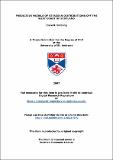Files in this item
Predictive models of cetacean distributions off the west coast of Scotland
Item metadata
| dc.contributor.advisor | Hammond, Philip S. | |
| dc.contributor.advisor | Gordon, Jonathan | |
| dc.contributor.author | Embling, Clare B. | |
| dc.coverage.spatial | vi, 252, 13 p. | en |
| dc.date.accessioned | 2009-03-19T15:13:49Z | |
| dc.date.available | 2009-03-19T15:13:49Z | |
| dc.date.issued | 2008-11-27 | |
| dc.identifier | uk.bl.ethos.552192 | |
| dc.identifier.uri | https://hdl.handle.net/10023/640 | |
| dc.description.abstract | The main purpose of this study was to produce and test the reliability of predictive models of cetacean distributions off the west coast of Scotland. Passive acoustic and visual surveys were carried out from platforms of opportunity between 2003 and 2005. Acoustic identifications were made primarily of harbour porpoises (Phocoena phocoena), delphinids, and sperm whales (Physeter macrocephalus). Generalised Additive Models (GAMs) were used to relate species’ distributions to a range of environmental variables over a range of temporal and spatial scales. Predictive models of delphinid distributions showed both inter-annual and inter-month variations. Combining all data for all months and years resulted in a model that combined the environmental influences from each monthly and yearly model. Overall, delphinids were found to associate with the deep (> 400m) warm water (10.5°C-12.5°C), and in areas of deep thermocline. Relationships between sperm whales and environmental variables were consistent over changes in grain size (9 km or 18 km), but not between areas. Although sperm whales were distributed in deep water characterised by weak thermoclines and strong haloclines in the most northerly area (Faroe-Shetland Channel), they were found in deep productive areas with cold surface temperature in the more southerly waters (Rockall Trough). Within the southern Inner Hebrides, high use areas for harbour porpoises were consistently predicted over time (in years) and with differing survey techniques (acoustic versus visual), but not over space (southern Inner Hebrides versus whole of the Inner Hebrides). Harbour porpoises were mainly distributed in areas with low tidal currents and with higher detection rates during spring tides. The use of prey as a predictor variable within models of delphinid distribution shows some promise: there were correlations between delphinid and herring (Clupea harengus) in shelf-waters in 2005 but not in 2004. These models can be used in mitigating acoustic threats to cetaceans in predicted high use areas off the west coast of Scotland. | en |
| dc.format.extent | 8065470 bytes | |
| dc.format.mimetype | application/pdf | |
| dc.language.iso | en | en |
| dc.publisher | University of St Andrews | |
| dc.rights | Creative Commons Attribution-NonCommercial-NoDerivs 3.0 Unported | |
| dc.rights.uri | http://creativecommons.org/licenses/by-nc-nd/3.0/ | |
| dc.subject | Cetacean | en |
| dc.subject | GAM | en |
| dc.subject | Harbour porpoise | en |
| dc.subject | Phocoena phocoena | en |
| dc.subject | Delphinid | en |
| dc.subject | Sperm whale | en |
| dc.subject | Physeter macrocephalus | en |
| dc.subject | Habitat model | en |
| dc.subject | Predictive model | en |
| dc.subject | Scotland | en |
| dc.title | Predictive models of cetacean distributions off the west coast of Scotland | en |
| dc.type | Thesis | en |
| dc.contributor.sponsor | Natural Environment Research Council (NERC) | en |
| dc.contributor.sponsor | Defence Science and Technology Laboratory (Great Britain) | en |
| dc.type.qualificationlevel | Doctoral | en |
| dc.type.qualificationname | PhD Doctor of Philosophy | en |
| dc.publisher.institution | The University of St Andrews | en |
This item appears in the following Collection(s)
Except where otherwise noted within the work, this item's licence for re-use is described as Creative Commons Attribution-NonCommercial-NoDerivs 3.0 Unported
Items in the St Andrews Research Repository are protected by copyright, with all rights reserved, unless otherwise indicated.


